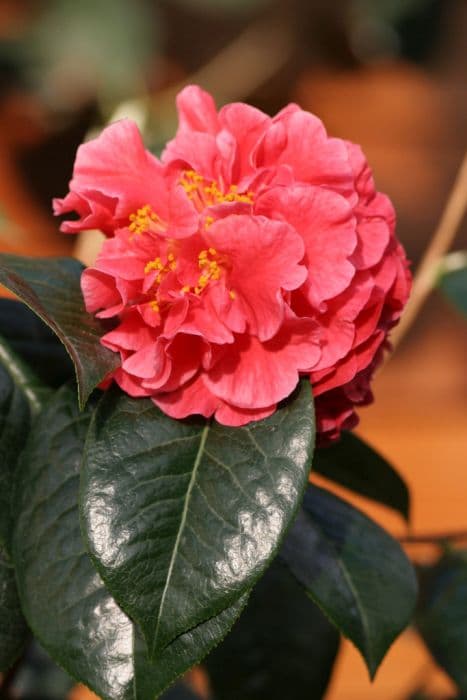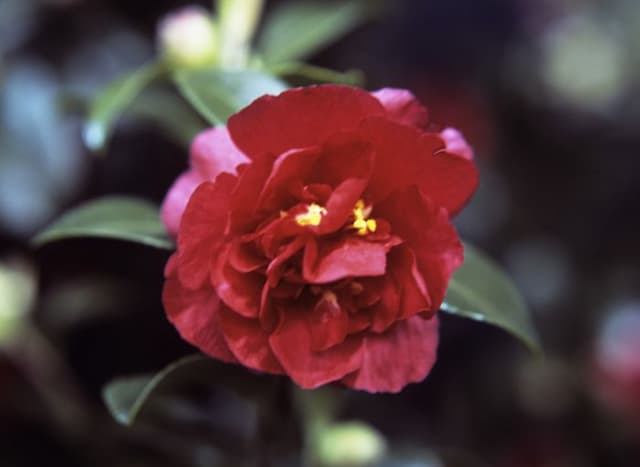Rose Quartz Williamsii Camellia Camellia × williamsii 'Rose Quartz'

ABOUT
The Camellia 'Rose Quartz' showcases an alluring visual appeal characterized by its stunning floral displays and elegant foliage. The plant bears exquisite flowers that are notable for their quintessential camellia form and delicate coloration. These blooms exhibit a soft and romantic pale pink hue, reminiscent of the gentle luster of rose quartz crystal. Each flower is intricately composed of multiple petals, often arranged in overlapping concentric circles that create a sense of depth and richness. Nestled among the flowers are the plant's glossy green leaves, which provide a lush and vibrant backdrop. These leaves have a classic oblong shape with slightly serrated edges, emanating a healthy sheen that accentuates the overall elegance of the plant. The contrast between the tender pink of the flowers and the vigorous green of the leaves further amplifies the plant's visual charm, making it a striking addition to any garden setting. Throughout the blooming season, the 'Rose Quartz' camellia becomes a focal point of natural beauty, attracting admirers with its serene color palette and sophisticated floral structure. While the overall size and dimensions of the plant are not within the scope of this description, the poise and presence of its blossoms ensure that it makes an impressive impact regardless of its stature. With its enchanting appearance and timeless grace, the Camellia 'Rose Quartz' is a botanical jewel that embodies the harmonious blend of subtlety and allure.
About this plant
 Names
NamesFamily
Theaceae
Synonyms
Williams' Camellia, Williamsii Camellia
Common names
Camellia × williamsii 'Rose Quartz'.
 Toxicity
ToxicityTo humans
Camellia 'Rose Quartz' is generally considered non-toxic to humans. Ingesting parts of this plant should not cause any significant symptoms of poisoning or adverse health consequences.
To pets
Camellia 'Rose Quartz' is also typically non-toxic to pets. Consumption of this plant by animals is unlikely to result in poisoning or serious health issues.
 Characteristics
CharacteristicsLife cycle
Perennials
Foliage type
Evergreen
Color of leaves
Green
Flower color
Pink
Height
8-10 feet (2.4-3.0 meters)
Spread
6-8 feet (1.8-2.4 meters)
Plant type
Shrub
Hardiness zones
7
Native area
Japan China
Benefits
 General Benefits
General Benefits- Aesthetic Appeal: Camellia × williamsii 'Rose Quartz' is renowned for its beautiful rose-pink flowers, adding vibrant color to gardens when in bloom.
- Winter Blooming: This plant flowers in the winter months, providing color and interest during a season when many plants are dormant.
- Evergreen Foliage: It retains its leaves year-round, ensuring that the garden remains green and lush even when the plant is not flowering.
- Low Maintenance: Once established, Camellia × williamsii 'Rose Quartz' requires relatively minimal upkeep beyond occasional pruning and feeding.
- Durability: It's known for its hardiness and can withstand various conditions, making it suitable for different garden settings.
- Pollinator Friendly: The flowers can attract pollinators such as bees, contributing to the health of the local ecosystem.
- Versatile Landscaping: This camellia can be used for borders, specimen planting, or even container gardening, offering great versatility in landscape design.
 Medical Properties
Medical PropertiesThis plant is not used for medical purposes.
 Air-purifying Qualities
Air-purifying QualitiesThis plant is not specifically known for air purifying qualities.
 Other Uses
Other Uses- As a natural dye: The petals of Camellia × williamsii 'Rose Quartz' can be used to create natural dyes for fabrics, offering a range of soft pink hues.
- Artistic inspiration: Artists may draw inspiration from the flower's form and color, using it as a subject for paintings, drawings, and other art pieces.
- Culinary decoration: Edible blooms can be crystallized or used fresh to decorate cakes and desserts for an elegant touch.
- Photographic subject: The plant's beautiful blooms make it a popular choice for photography, especially close-ups and macro photography.
- Floral crafts: Petals and leaves from the Camellia × williamsii 'Rose Quartz' can be used in crafting, such as in the creation of pressed flowers or potpourri.
- Jewelry making: Dried petals and buds can be encased in resin to make unique, floral-themed jewelry items such as pendants and earrings.
- Wedding decor: Its elegant flowers are incorporated into wedding bouquets, boutonnieres, and table arrangements.
- Garden design: Used in thematic gardens, such as Victorian or cottage-style gardens to add an element of classic beauty.
- Companion planting: It can be planted alongside other acid-loving plants to create visually appealing and harmonious garden beds.
- Educational tool: The plant can serve as a live specimen for horticulture students studying hybridization and plant propagation techniques.
Interesting Facts
 Feng Shui
Feng ShuiThe Camellia is not used in Feng Shui practice.
 Zodiac Sign Compitability
Zodiac Sign CompitabilityThe Camellia is not used in astrology practice.
 Plant Symbolism
Plant Symbolism- Admiration: Camellia x williamsii 'Rose Quartz', commonly known simply as Camellia, represents deep admiration and respect for someone. Its beautiful blossoms convey the message of the giver's genuine esteem.
- Perfection: Camellias are often associated with perfection due to their flawless and elegant blooms, symbolizing the perfect beauty of the recipient or the ideal nature of love and affection.
- Longevity and Faithfulness: With their long-lasting nature, Camellias symbolize the enduring quality of love, suggesting a commitment that stands the test of time. The flower embodies faithfulness in relationships.
- Affection: The warmth and coziness of the Rose Quartz variety of Camellia suggest a gentle and steady affection, whether between friends, family, or romantic partners.
- Devotion: Gifting Camellias can be a way to show deep devotion and loyalty, as the flower's robustness and ability to bloom through different conditions mirror the steadfast nature of devoted love.
 Water
WaterThe Williamsii Camellia 'Rose Quartz' should be watered deeply to ensure the soil is moist but not saturated, typically requiring about 1 inch of water per week. During dry spells or in the heat of summer, it may need additional water, possibly twice a week. It's important not to over-water as Camellias dislike standing in water. Using a soaker hose or drip irrigation can provide gradual, even watering. Adjust the amount of water according to season and weather conditions, but as a general rule, ensure the plant receives the equivalent of approximately 1-2 gallons of water weekly.
 Light
LightWilliamsii Camellias 'Rose Quartz' prefer bright but filtered light. They should be planted in a spot that is shielded from harsh afternoon sunlight but receives morning light or dappled shade throughout the day. The ideal location would be under the canopy of tall trees that provide a light shade, or on the east side of a building where it will be protected from the intense late-day sun.
 Temperature
TemperatureThe Williamsii Camellia 'Rose Quartz' thrives in temperatures ranging from 60 to 75 degrees Fahrenheit. It can survive minimum temperatures of 20 degrees Fahrenheit, but prolonged exposure to cold can damage the plant. Keep them in a location sheltered from cold winds and frost, and they should not be exposed to temperatures above 85 degrees Fahrenheit for extended periods as this can cause stress to the plant.
 Pruning
PruningPrune the Williamsii Camellia 'Rose Quartz' to maintain its shape and remove any spent blooms and dead or diseased wood. The best time to prune is after it finishes blooming in spring. Light pruning can be done annually, but a more extensive pruning should only be done every few years to rejuvenate older plants. Avoid heavy pruning as this can reduce flowering.
 Cleaning
CleaningAs needed
 Soil
SoilWilliamsii Camellia, including the 'Rose Quartz' cultivar, thrives best in acidic soil with a pH of 5.5 to 6.5. The ideal soil mix is well-draining and rich in organic matter, composed of equal parts peat, pine bark, and perlite or sand. Regularly adding compost can also help maintain soil fertility and structure, promoting healthy growth.
 Repotting
RepottingWilliamsii Camellias should be repotted every 2-3 years. They prefer to be slightly root-bound, so repotting too frequently is unnecessary. Choose a container only slightly larger than the previous one to avoid excessively damp soil which can lead to root rot.
 Humidity & Misting
Humidity & MistingWilliamsii Camellias prefer moderate to high humidity levels. The best range for this plant is between 40-60% humidity. If the air is too dry, especially indoors during winter, it may be beneficial to use a humidifier or place a water tray near the plant to raise the humidity.
 Suitable locations
Suitable locationsIndoor
Ensure bright, indirect light and keep soil moist for indoor Williamsii Camellia.
Outdoor
Plant in partial shade; shelter from strong winds; mulch to retain moisture.
Hardiness zone
7-9 USDA.
 Life cycle
Life cycleThe life of Camellia × williamsii 'Rose Quartz', typically referred to as Williamsii hybrid camellia, begins with seed germination, which requires a warm and moist environment to occur. After germination, the seedling grows into a juvenile plant, developing foliage and a root system, but it will not yet produce flowers. As the plant matures into an adult, it enters a phase of vegetative growth where it develops a robust structure with evergreen leaves, and after a few years, it becomes capable of flowering, usually in late winter to early spring. The blossoms are delicate pink and may attract pollinators, although camellias often rely on self-pollination. Following pollination, the plant produces seed pods that, when mature, open to release seeds, thereby completing the reproductive cycle. Finally, Williamsii hybrid camellias can live for many years, with some individuals surviving for over a century if grown under optimal conditions.
 Propogation
PropogationPropogation time
Spring-Early Summer
Camellia × williamsii 'Rose Quartz', commonly known as Rose Quartz Camellia, is typically propagated through semi-hardwood cuttings. This method is generally conducted in late summer, after the season's new growth has begun to mature and harden slightly. To propagate, a cutting of about 4 to 6 inches (approximately 10 to 15 centimeters) in length is taken with several leaves remaining. The lower leaves are removed, and the cut end is often dipped in a rooting hormone to encourage root development. The cutting is then inserted into a pot filled with a mixture of peat and perlite to provide good drainage and air circulation. It's important to maintain a humid environment for the cuttings, which can be achieved by placing a plastic cover over the pot, and to keep them out of direct sunlight while they root over a period of several weeks to a few months.









